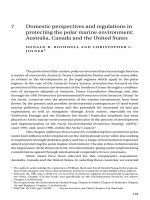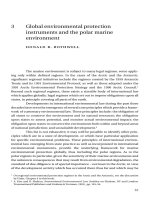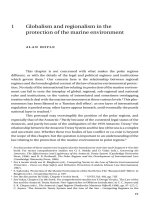Marine geology
Bạn đang xem bản rút gọn của tài liệu. Xem và tải ngay bản đầy đủ của tài liệu tại đây (255.37 KB, 4 trang )
Marine
Geology
Marine Sediments
errigenous and Pelagic
The two main classifications of marine sediments are
terrigenous and pelagic. Terrigenous sediments are derived
from land and found near shore. Normally, the go from
rivers to costal regions. Pelagic sediments settle slowly out
of the water column and are deposited all over the ocean..
Pelagic sediments are mostly associated with deep sea
areas.
The further away from land the smaller the sediment size.
Terrigenous
Terrigenous sediments are usually classified by their size. Sediment
grain size depends on the energy of the depositional environment,
with more energy leading to larger grain sizes. A steep mountain
stream, where water flows quickly downhill, might have very large
grain sizes, from gravel to pebbles. A river bed, where currents are
slower, might be filled with sand. Beaches, where waves crash
against the shore and the surf runs in and out, often have sandsized particles as well. Farther offshore, where the water is less
active, terrigenous materials will be smaller or clay size particles.
Pelagic
Pelagic sediments are classified by composition, not size. The size of
pelagic sediments is uniformly pretty small. There are four main
compositional groups for marine sediment which are Lithogenous,
Biogenous, Hydrogenous, and Cosmogenous.
Lithogenous - This is sediment that is derived from rocks.
Biogenous - This is sediment that is derived from living organisms.
Hydrogenous - This sediment is derived from the ions in seawater.
Cosmogenous -The Earth is continually being bombarded from space by meteors and
cosmic dust.









